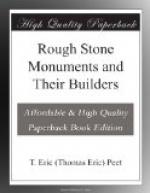The most probable theory is that the circles are religious monuments of some kind. What the nature of the worship carried on in them was it is quite impossible to determine. It may be that some at least were built near the graves of deified heroes to whose worship they were consecrated. On the other hand, it is possible that they were temples dedicated to the sun or to others of the heavenly bodies. Whether they served for the taking of astronomical observations or not is a question which cannot be decided with certainty, though the frequency with which menhirs occur in directions roughly north-east of the circles is considered by some as a sign of connection with the watching of solar phenomena.
Dolmens of simple type are not common in England, though they occur with comparative frequency in Wales, where the best known are the so-called Arthur’s Quoit near Swansea, the dolmen of Pentre Ifan in Pembrokeshire, and that of Plas Newydd on the Menai Strait: in Anglesey they are quite common. In England we have numerous examples in Cornwall, especially west of Falmouth, among which are Chun Quoit and Lanyon Quoit. There are dolmens at Chagford and Drewsteignton in Devonshire, and there is one near the Rollright Circle in Oxfordshire.
Many of the so-called cromlechs of England are not true dolmens, but the remains of tombs of more complicated types. Thus the famous Kit’s Coty House in Kent was certainly not a dolmen, though it is now impossible to say what its form was. Wayland the Smith’s Cave was probably a three-chambered corridor-tomb covered with a mound. The famous Men-an-tol in Cornwall may well be all that is left of a chamber-tomb of some kind. It is a slab about 3-1/2 feet square, in which is a hole 1-1/2 feet in diameter. There are other stones standing or lying around it. It is known to the peasants as the Crickstone, for it was said to cure sufferers from rickets or crick in the back if they passed nine times through the hole in a direction against the sun. The Isle of Man possesses a fine sepulchral monument on Meayll Hill. It consist of six T-shaped chamber-tombs arranged in a circle with entrances to the north and south. There is also a corridor-tomb, known as King Orry’s Grave, at Laxey, and another with a semicircular facade at Maughold.
Among the megalithic monuments of our islands the chambered barrows hold an important place. It is well known that in the neolithic period the dead in certain parts of England were buried under mounds of not circular but elongated shape. These graves are commonest in Wiltshire and the surrounding counties of Dorsetshire, Somersetshire, and Gloucestershire. A few exist in other counties. Some contain no chamber, while others contain a structure of the megalithic type. It is with these latter that we have here to deal. Chambered long barrows are most frequent in Wiltshire, though they do occur in other counties, as, for example, Buckinghamshire, where the famous Cave of Wayland the Smith is certainly the remains of a barrow of this kind. In Derbyshire and Staffordshire a type of chambered mound does occur, but it seems uncertain from the description given whether it is round or elongated.




